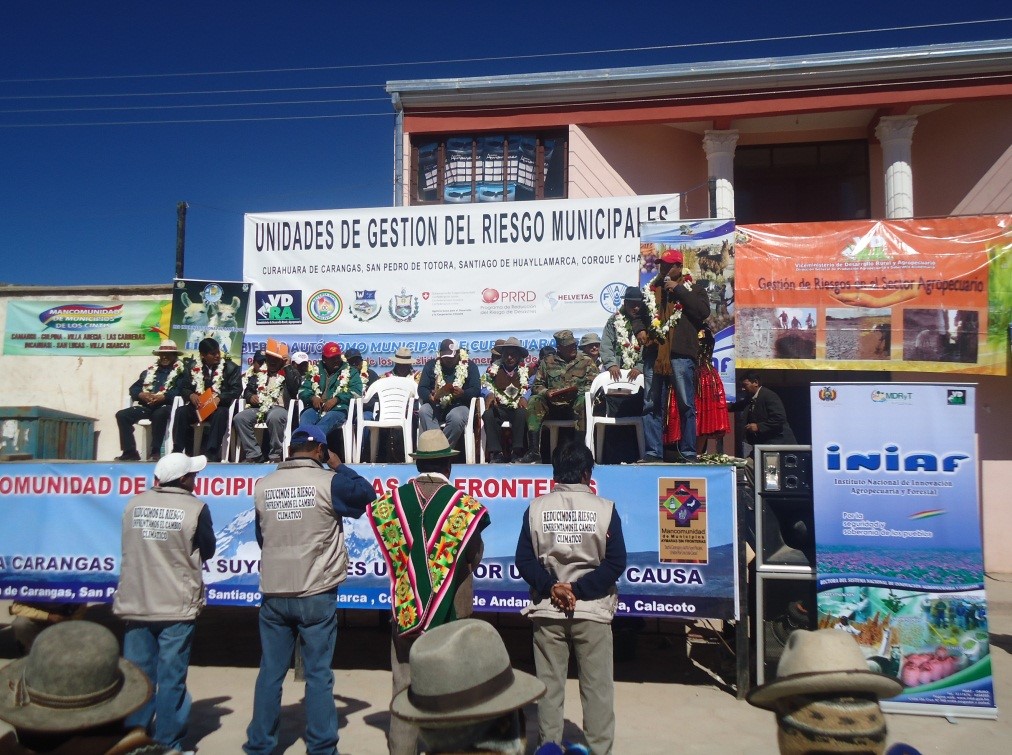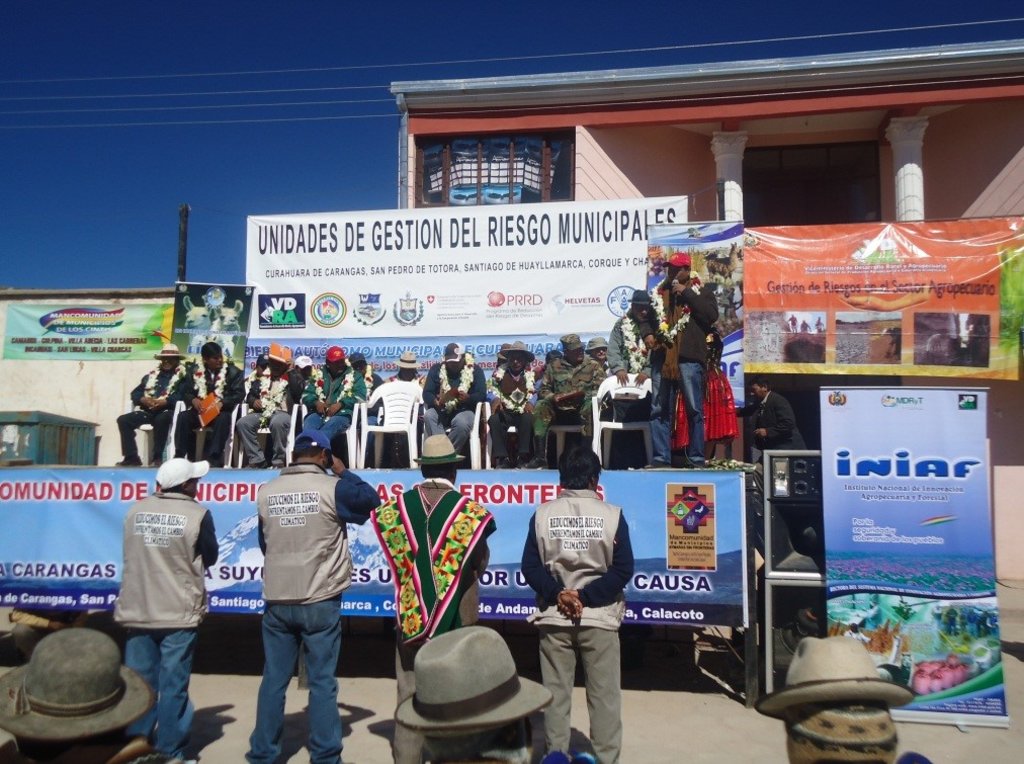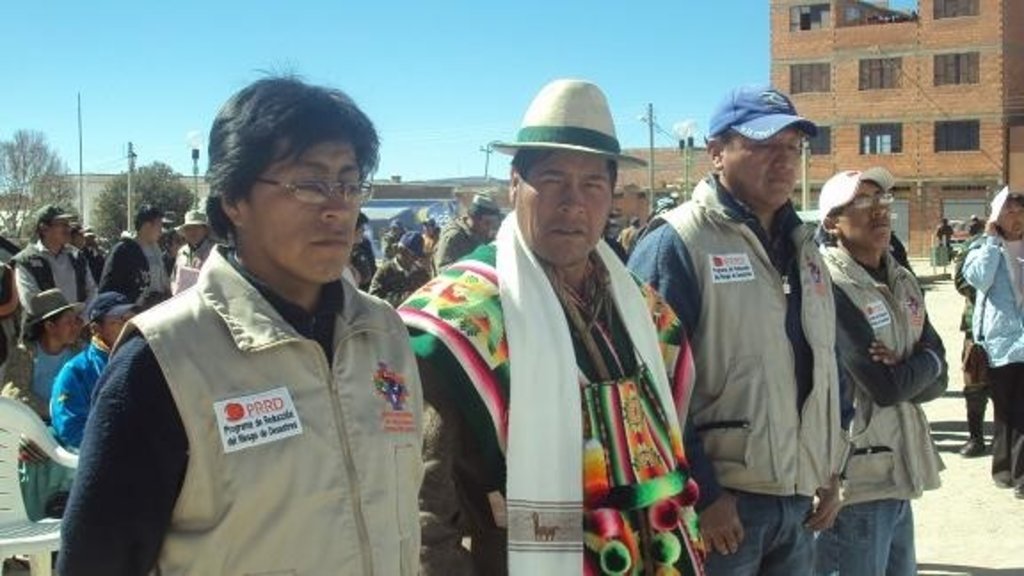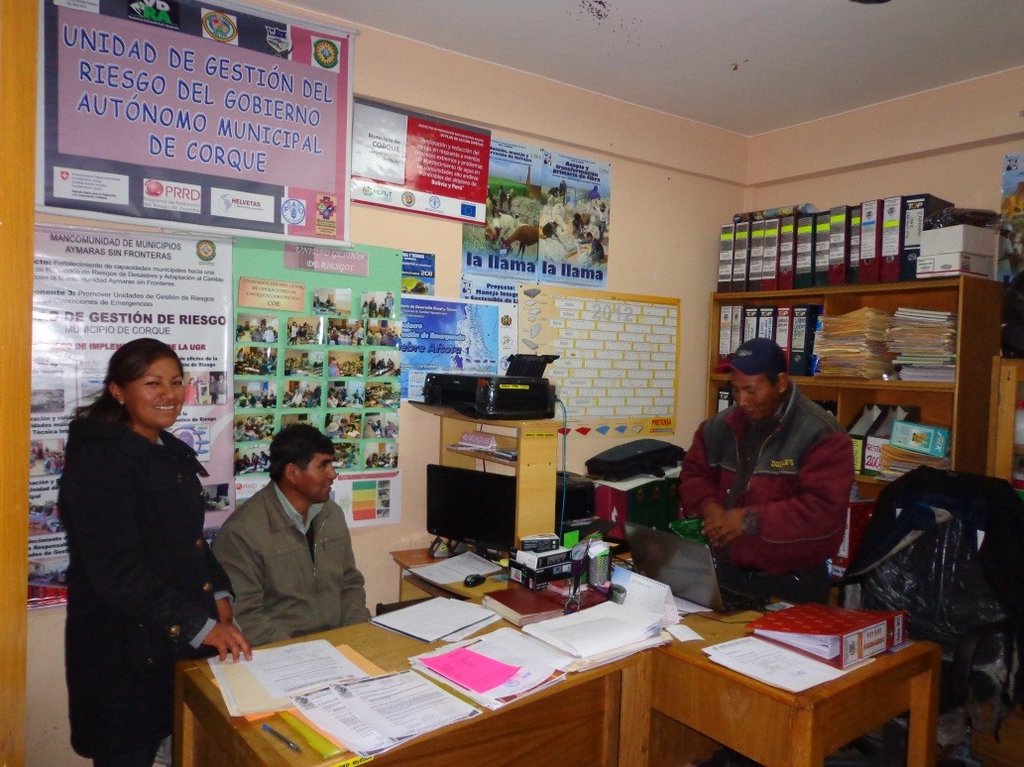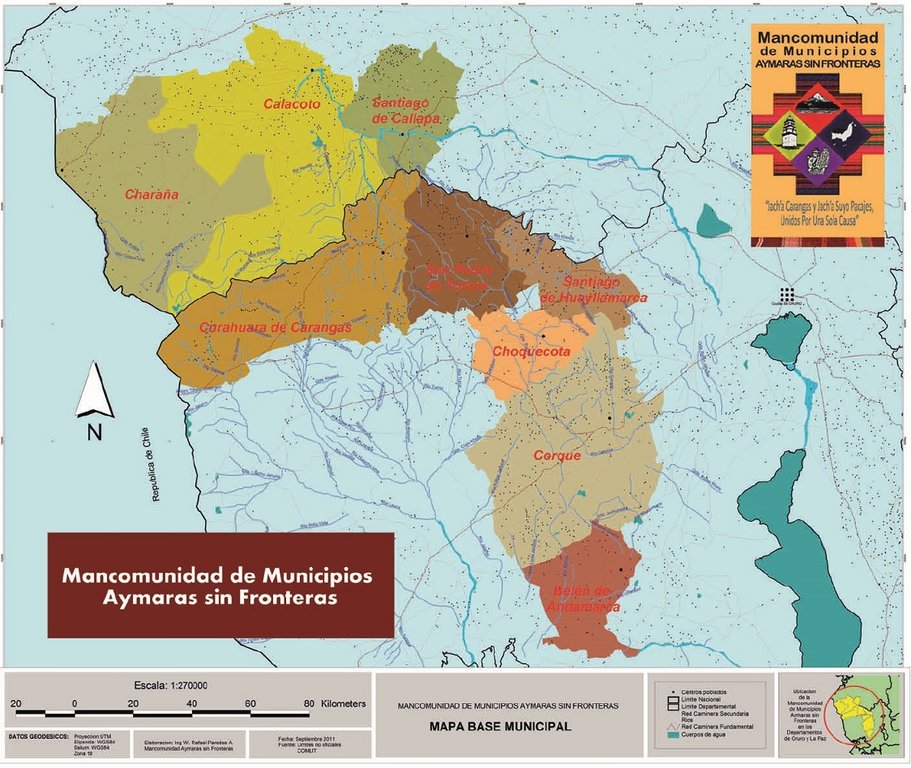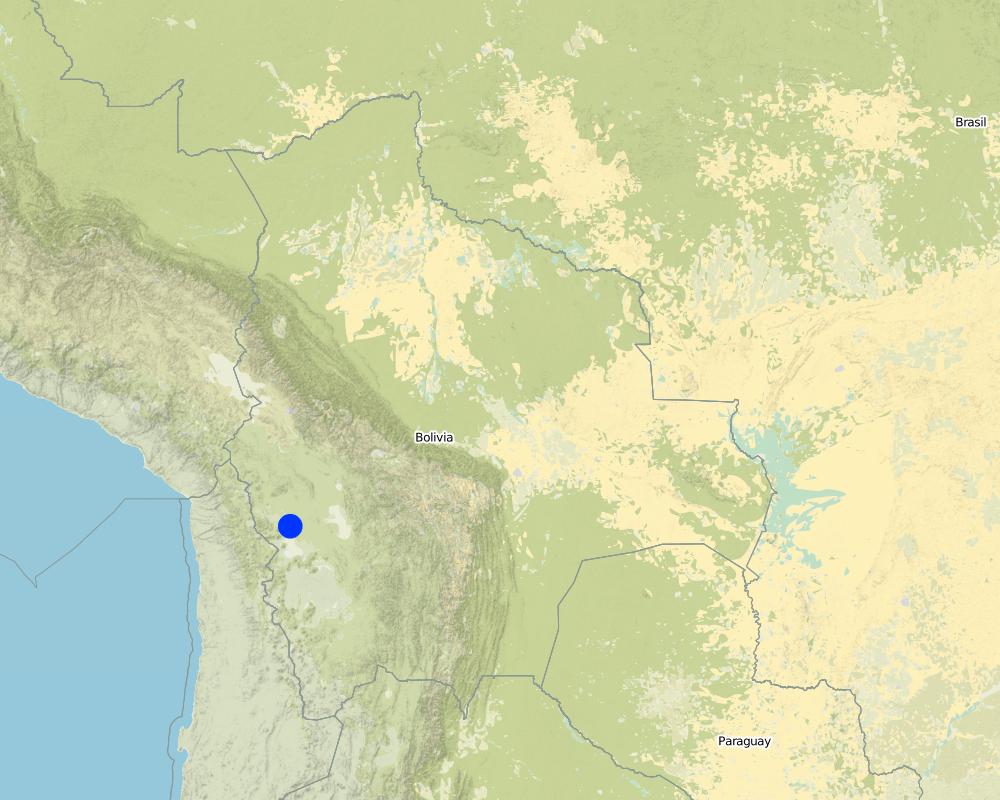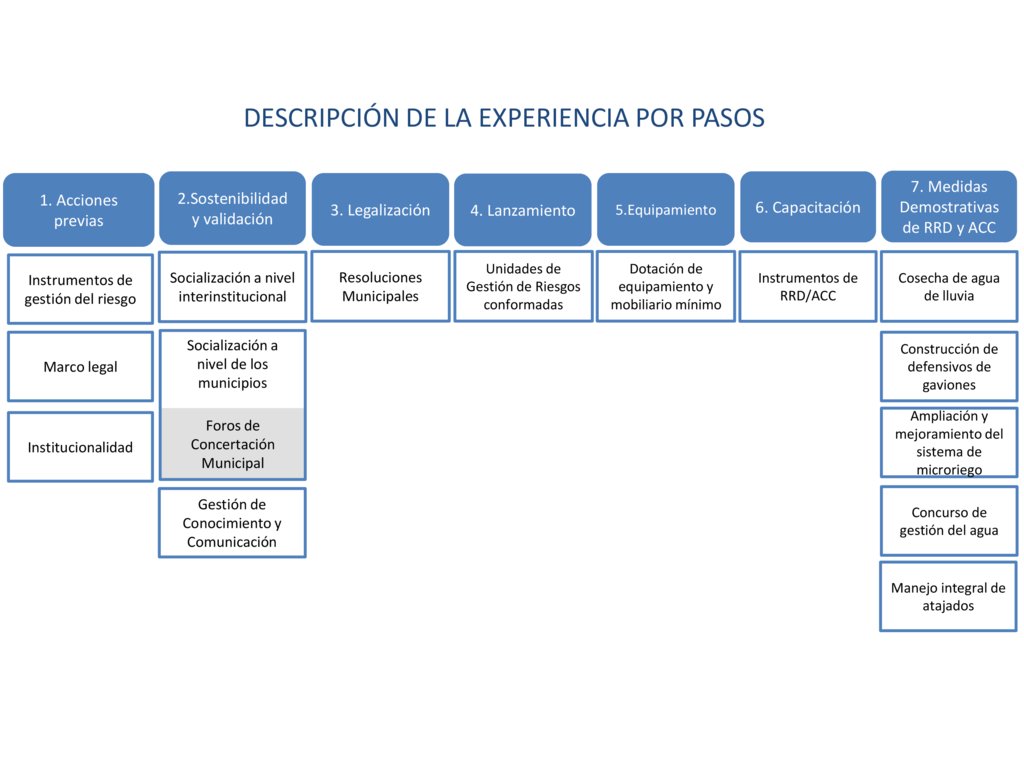Creating Municipal Risk Management Units (UGR) with a participative approach [Bolivia, Plurinational State of]
- Creation:
- Update:
- Compiler: Oscar Paz
- Editors: Consuelo Aranda, Eveline Studer
- Reviewers: Johanna Jacobi, Eveline Studer, Alexandra Gavilano
Procesos participativos en la creación de UGRs municipales
approaches_692 - Bolivia, Plurinational State of
View sections
Expand all Collapse all1. General information
1.2 Contact details of resource persons and institutions involved in the assessment and documentation of the Approach
Key resource person(s)
Técnicos de la región:
Paz Oscar
+59122419585 / +59170676495
oscar.paz@helvetas.org / osquipaz@gmail.com
HELVETAS Swiss Intercooperation – Disaster Risk Reduction Project
Calle Rosendo Gutierrez 704 La Paz
Bolivia, Plurinational State of
Name of project which facilitated the documentation/ evaluation of the Approach (if relevant)
Book project: where people and their land are safer - A Compendium of Good Practices in Disaster Risk Reduction (DRR) (where people and their land are safer)Name of the institution(s) which facilitated the documentation/ evaluation of the Approach (if relevant)
HELVETAS (Swiss Intercooperation)1.3 Conditions regarding the use of data documented through WOCAT
When were the data compiled (in the field)?
12/06/2013
The compiler and key resource person(s) accept the conditions regarding the use of data documented through WOCAT:
Yes
2. Description of the SLM Approach
2.1 Short description of the Approach
This is the result of an interinstitutional cooperation carried out thanks to the commitment of many stakeholders at different decision-making levels in order to manage disaster risks. UGRs (Risk Management Units) are created to institutionalize risk and their creation is supported by participative action, which ensures their sustainability and resilience
2.2 Detailed description of the Approach
Detailed description of the Approach:
The approach is based on establishing risk management institutionality and governability by creating municipal Risk Management Units with full participation of local stakeholders. The purpose is to ensure legality and legitimacy in the construction of institutionality to manage risk in rural municipalities and to provide a method of collective construction.
The steps followed for implementation were: 1) discussion and knowledge of the issue; b) participative creation of instruments such as risk maps; c) demonstrative projects; d) creation of Risk Management Units with established roles.
The process also included sensitization of mayors on the importance of creating institutionality. Training workshops were carried out for this purpose and municipal councils were involved and trained on the importance of managing these actions through the Risk Management Unit.
Users appreciate the broad participation in this process as well as the joint discussions of its scope and particularly the use of having a unit that will manage risk and influence in planning actions.
2.3 Photos of the Approach
General remarks regarding photos:
The participative process with and from the people empowers risk management.
2.5 Country/ region/ locations where the Approach has been applied
Country:
Bolivia, Plurinational State of
Region/ State/ Province:
Altiplano, Departamento de Oruro
Further specification of location:
Municipios de Curahuara de Carangas; San Pedro de Totora; Belen de Andamarca; Corque
Comments:
The aforementioned municipalities are located in the Departament of Oruro, Bolivia, in the southwestern area of the country.
Map
×2.6 Dates of initiation and termination of the Approach
Indicate year of initiation:
2011
Year of termination (if Approach is no longer applied):
2013
Comments:
The experience took place during the third phase of the Risk Disaster Reduction Program (PRRD for its acronym in Spanish) carried out by Swiss Cooperation in Bolivia, implemented by Helvetas Swiss Intercooperation, together with local partners from the association of Aymaras Sin Frontera municipalities.
2.7 Type of Approach
- project/ programme based
2.8 Main aims/ objectives of the Approach
Creating institutionality for risk management in municipalities throughout the region by building on demonstrative experiences in Reduction of Disaster Risks and Adaptation to Climate Change, such as the creation of risk maps, capacity building and setting up an early alert system.
Set up Risk Management Units with full participation of and articulated with local and national institutions, within the established legal framework.
2.9 Conditions enabling or hindering implementation of the Technology/ Technologies applied under the Approach
social/ cultural/ religious norms and values
- enabling
Local native authorities and institutions related to the issue have participated since the beginning; this helps developing the approach.
availability/ access to financial resources and services
- enabling
Having resources for demonstrative actions greatly helps people to understand the importance of managing disaster risks.
institutional setting
- enabling
If institutions leading the process are aware of the importance of the issue, this greatly helps with its implementation.
collaboration/ coordination of actors
- enabling
The processes are created and facilitated by involving international cooperation as well diverse institutions –local, municipal, regional and national– in the process.
legal framework (land tenure, land and water use rights)
- enabling
In this specific case, there was a legal framework on which we built on to have incidence in the process.
policies
- enabling
The process is greatly enabled with current national policies to integrate risk management and adaptation to climate change in the subnational institutional structure. However, it is of utmost importance to have policy support for the process in order to enable it. The Vice ministry of Rural Development and Agriculture supported efforts to strengthen institutionality by responding to initiatives within the sector related to early agricultural alerts, thus generating internal debates and promoting the participation of different stakeholders, and to internalize the need to work towards reducing disaster risks in municipal planning. The Vice ministry for Civil Defense also promoted the enforcement of corresponding policies and the creation of the Emergency Operative Committee.
knowledge about SLM, access to technical support
- enabling
Generating processes to build capacities allows better understanding of the issues and enables support for institutional processes.
- hindering
The lack of information on the topic and the lack of technical support hinders the process. In this specific case, it was necessary to generate knowledge on the issue from the bottom up, since the technicians and authorities in the area were not familiar with the issue or the way of implementing the institutionality. For example, they were not familiar with their roles and functions or were not familiar with procedures they could use to make and use risk maps.
3. Participation and roles of stakeholders involved
3.1 Stakeholders involved in the Approach and their roles
- local land users/ local communities
Native indigenous authorities representing land users in the area.
Participation in training, information and sensitization meetings.
- NGO
HELVETAS Swiss Intercooperation with PRRD– Project for the Reduction of Disaster Risks –
The national NGO Promoción a la Sustentabilidad y Conocimientos Compartidos. PROSUCO (Asociación Promoción de la Sustentabilidad y Conocimientos Compartidos)
Capacity development. Sensitization workshops. Use of methodologies to reduce the risk of disasters.
- local government
Municipalities of the Aymaras Sin Fronteras Association.
Active role in the process, in the level where people are trained and at the level were influence can further risk management in the municipality.
Coordinator of the tasks referred to development of instruments and bringing together participating local and regional organizations.
- national government (planners, decision-makers)
Vice ministry for Rural Development and Agriculture
Vice ministry for Civil Defense
Stakeholders are motivated and committed in helping create institutionality to manageg disaster risks, particularly in the agricultural sector.
- international organization
Swiss Cooperation in Bolivia (COSUDE)
FAO
Funding for the program for Reduction of Disaster Risks (COSUDE)
Funding for meteorological stations (FAO)
If several stakeholders were involved, indicate lead agency:
Municipalities of the Aymaras Sin Fronteras Association.
3.2 Involvement of local land users/ local communities in the different phases of the Approach
| Involvement of local land users/ local communities | Specify who was involved and describe activities | |
|---|---|---|
| initiation/ motivation | interactive | Native indigenous authorities were involved in the process together with municipal governments in the region. Full participation in the process, discussion on themes. Participation in learning processes. |
| planning | interactive | Municipalities played an important role because the extreme climate events in the area generate significant economic losses. |
| implementation | interactive | The municipalities and the Vice ministry for Civil Defense and the Vice ministry for Rural Development and agriculture were involved in the process in order to create Municipal Risk Management Units. |
| monitoring/ evaluation | interactive | Municipalities and national institutions followed the process until its conclusion. |
3.3 Flow chart (if available)
Description:
The flowchart shows the process, and highlights a series of actions that determine its success.
Author:
Consuelo Aranda/Oscar Paz
3.4 Decision-making on the selection of SLM Technology/ Technologies
Specify who decided on the selection of the Technology/ Technologies to be implemented:
- all relevant actors, as part of a participatory approach
Explain:
The process was participative from the start and had a significant involvement from local institutions.
Specify on what basis decisions were made:
- personal experience and opinions (undocumented)
- Participative approach in all events and processes
4. Technical support, capacity building, and knowledge management
4.1 Capacity building/ training
Was training provided to land users/ other stakeholders?
Yes
- Municipal technicians and local authorities.
Form of training:
- demonstration areas
- public meetings
- courses
Subjects covered:
Implementation of demonstrative ris management projects
Training for the participative creation of risk maps
Discussions on the importance of having early alert systems
Discussions on the importance of including risk management in municipal planning and budget
Discussion on the need to have UGRs (Risk Management Units)
4.2 Advisory service
Do land users have access to an advisory service?
Yes
Specify whether advisory service is provided:
- at permanent centres
Describe/ comments:
Through the Risk Management Unit, the municipality provides assessment on the issue. The assessment includes information on potential climate events, problems these can cause on production and the course of action institutions can take in case of emergencies.
4.3 Institution strengthening (organizational development)
Have institutions been established or strengthened through the Approach?
- yes, greatly
Specify the level(s) at which institutions have been strengthened or established:
- local
Describe institution, roles and responsibilities, members, etc.
Municipalities were the institutions that were most strengthened as a result of the process, since they received instruments for risk management planning, such as maps and the Early Alert System. Their staff was trained on the issue and risk management institutionality was created.
Specify type of support:
- financial
- capacity building/ training
Give further details:
Financial support served to execute demonstrative projects that served as local counterpart contribution.
Most of the support provided through workshops helped generate and develop capacities.
4.4 Monitoring and evaluation
Is monitoring and evaluation part of the Approach?
Yes
If yes, is this documentation intended to be used for monitoring and evaluation?
Yes
Comments:
Disaster Risk Reduction Program had a monitoring system for effects and results. By creating legally supported institutionality, the effects were monitored and budgets were allotted to ensure the operation of risk management units to provide support to the early alert system. The system consisted of local authorities and technicians gathering on-site information through structured surveys and field visits.
4.5 Research
Was research part of the Approach?
No
5. Financing and external material support
5.1 Annual budget for the SLM component of the Approach
If precise annual budget is not known, indicate range:
- 10,000-100,000
Comments (e.g. main sources of funding/ major donors):
Swiss Cooperation in Bolivia provided resources while the beneficiaries of the Association of Municipalities Aymaras sin Frontera provided counterpart contributions.
5.2 Financial/ material support provided to land users
Did land users receive financial/ material support for implementing the Technology/ Technologies?
Yes
If yes, specify type(s) of support, conditions, and provider(s):
A series of demonstrative works were funded, such as water harvest systems (in Spanish, atajados) and tanks for water harvest. The Disaster Risk Reduction Program and the municipalities involved funded the storage tanks together. The program provided the required funds for all the machinery required by the local water harvest systems (atajados). The counterpart contribution consisted in providing labor for simple works.
5.3 Subsidies for specific inputs (including labour)
- labour
| To which extent | Specify subsidies |
|---|---|
| partly financed | The beneficiaries of the project provided labor to install storage tanks for harvesting rain water and build the pedestals on which the tanks were set. The beneficiaries provided untrained labor that crowned and finished the water collecting systems. |
- equipment
| Specify which inputs were subsidised | To which extent | Specify subsidies |
|---|---|---|
| machinery | Payment was made through the Association of Municipalities and not directly through beneficiaries. | |
| tools | Payment was made through the Association of Municipalities and not directly through beneficiaries. | |
| Tanques de almacenamiento | partly financed | Storage tanks for rainwater harvest. The project provided 50% of the tanks while the municipalities provided the remaining 50%. |
- infrastructure
| Specify which inputs were subsidised | To which extent | Specify subsidies |
|---|---|---|
| Atajados para cosecha de agua | partly financed | Water collection systems to capture drinking waters for camelids. |
If labour by land users was a substantial input, was it:
- voluntary
Comments:
The water collection systems (atajados) benefitted community members who raise camelids; these beneficiaries also contributed untrained labor to execute complementary construction tasks.
5.4 Credit
Was credit provided under the Approach for SLM activities?
No
5.5 Other incentives or instruments
Were other incentives or instruments used to promote implementation of SLM Technologies?
Yes
If yes, specify:
Existing policies requiring municipalities for managing disaster risks served as the basis of the process. For this purpose, the Vice ministry for Rural Development and Agriculture and the Vice ministry for Civil Defense participated raising awareness on the existing policies. Though these entities did not provide any sort of funding, they did validate the process. As a result of these and other experiences, the Vice ministry for Civil Defense published a manual to create municipal risk management units, with the support of the Disaster Risk Reduction Program.
6. Impact analysis and concluding statements
6.1 Impacts of the Approach
Did the Approach enable evidence-based decision-making?
- No
- Yes, little
- Yes, moderately
- Yes, greatly
The municipal Risk Management Units created currently play an important role in risk management.
Los recursos necesarios para el funcionamiento de las UGRs, fueron institucionalizados. Es decir que como resultado los municipios integran en su presupuesto local los recursos para las UGRs.
Did the Approach improve knowledge and capacities of land users to implement SLM?
- No
- Yes, little
- Yes, moderately
- Yes, greatly
Municipal technicians learned about the issues and improved their skills to interpret risk maps, to understand the roles of risk units, the ways in which the diverse elements and actors in the projects interact and the actions that need to be taken in different stages of emergencies.
Did the Approach build/ strengthen institutions, collaboration between stakeholders?
- No
- Yes, little
- Yes, moderately
- Yes, greatly
Municipalities and social organizations involved were empowered by learning about the value and relevance of risk management and were actively involved in creating Risk Management Units (UGRs)
Did the Approach improve the capacity of the land users to adapt to climate changes/ extremes and mitigate climate related disasters?
- No
- Yes, little
- Yes, moderately
- Yes, greatly
The importance of reducing disaster risks was highlighted, especially in regards to prevention measures, and this, in turn, empowered the stakeholders.
6.2 Main motivation of land users to implement SLM
- reduced risk of disasters
The main motivation of land users was expressed in the way these undertook prevention measures to reduce their agricultural losses in the face of frost and droughts that are frequent in the area.
- enhanced SLM knowledge and skills
The stakeholders learned about the different alternatives and actions they can undertake to reduce the risk of disasters and about the importance of institutionalizing these responses.
6.3 Sustainability of Approach activities
Can the land users sustain what has been implemented through the Approach (without external support)?
- yes
If yes, describe how:
Las UGRs municipales que pueden darles apoyo en actividades de la gestión del riesgo de desastres.
6.4 Strengths/ advantages of the Approach
| Strengths/ advantages/ opportunities in the land user’s view |
|---|
| Municipal institutions have assumed their role in risk management and included Risk Management Units in their organic framework. |
| Strengths/ advantages/ opportunities in the compiler’s or other key resource person’s view |
|---|
| The approach strengthened governability of Disaster Risk Reduction and Climate Change Adaptation through planning actions at the level of municipalities. |
6.5 Weaknesses/ disadvantages of the Approach and ways of overcoming them
| Weaknesses/ disadvantages/ risks in the land user’s view | How can they be overcome? |
|---|---|
| The process is weakened when new politicians take office or municipal technicians are replaced with new ones. | Ensure the sustainability of the process through institutionality. By continuing the strengthening of capacities and involving more institutions in the process. |
| Weaknesses/ disadvantages/ risks in the compiler’s or other key resource person’s view | How can they be overcome? |
|---|---|
| The economic context is important; when municipal budgets are reduced, disaster risk reduction measures rarely are addressed as they should and, as a result, the funds for these are cut. | To have incidence among different institutions, specifically those working on social control, to lobby on the importance of having resources for the issue. |
7. References and links
7.1 Methods/ sources of information
- compilation from reports and other existing documentation
The project issued a series of quarterly reports (a total of 10) that stated the progress and difficulties of implementing the project, as well as achievements as expressed through indicators.
7.2 References to available publications
Title, author, year, ISBN:
Procesos participativos en la creación e implementación de UGRs municipales. Mancomunidad Aymaras sin fronteras, PRRD, 2014.
Available from where? Costs?
http://www.rrd.com.bo/wp-content/uploads/2015/publi_fases/fase_03/34ASF01.pdf
7.3 Links to relevant information which is available online
Title/ description:
Reducción del riesgo de desastres – Gobernanza del riesgo, colecion de documentos de capitalisacion y herramients, Helvetas, Cosude
URL:
www.rrd.com.bo
Title/ description:
Manual de Organización y Funcionamiento la Unidad de Gestión del Riesgo (UGR) , VIDECI, PRRD, 2013
URL:
http://www.rrd.com.bo/wp-content/uploads/2015/publi_fases/fase_03/10manual_iugr.pdf
Links and modules
Expand all Collapse allLinks
No links
Modules
No modules


